Related Research Articles

A chambered cairn is a burial monument, usually constructed during the Neolithic, consisting of a sizeable chamber around and over which a cairn of stones was constructed. Some chambered cairns are also passage-graves. They are found throughout Britain and Ireland, with the largest number in Scotland.

A megalith is a large stone that has been used to construct a prehistoric structure or monument, either alone or together with other stones. There are over 35,000 in Europe alone, located widely from Sweden to the Mediterranean sea.

The court cairn or court tomb is a megalithic type of chambered cairn or gallery grave. During the period, 3900–3500 BC, more than 390 court cairns were built in Ireland and over 100 in southwest Scotland. The Neolithic monuments are identified by an uncovered courtyard connected to one or more roofed and partitioned burial chambers. Many monuments were built in multiple phases in both Ireland and Scotland and later re-used in the Early Bronze Age.

Bant's Carn is a Bronze Age entrance grave located on a steep slope on the island of St Mary's in the Isles of Scilly, England. The tomb is one of the best examples of a Scillonian entrance grave. Below Bant's Carn, lies the remains of the Iron Age village of Halangy Down.
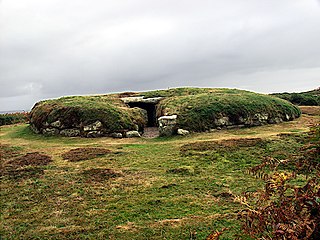
Porth Hellick Down is a Neolithic and Bronze Age archeological site located on the island of St Mary's, in the Isles of Scilly in Great Britain. The ancient burial monument encompasses a large cairn cemetery that includes at least six entrance graves, other unchambered cairns, and a prehistoric field system. The site is notable for having the largest assembly of surviving entrance graves.

Abernethy is a village in Perth and Kinross, Scotland, situated 8 miles (13 km) south-east of Perth.

Alyth is a town in Perth and Kinross, Scotland, five miles northeast of Blairgowrie and about 17 miles northwest of Dundee. In 2016 the town had an estimated population of 2,400.
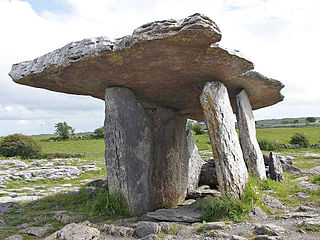
Poulnabrone dolmen is a large dolmen located in the Burren, County Clare, Ireland. Situated on one of the most desolate and highest points of the region, it comprises three standing portal stones supporting a heavy horizontal capstone, and dates to the Neolithic period, with estimates to between 4200 BC and 2900 BC. Although not the largest, it is the best known of the approximately 172 dolmens in Ireland.
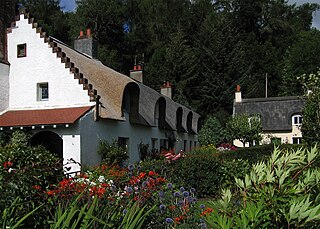
Fortingall is a small village in Glen Lyon, Perthshire, Scotland. Its nearest sizable neighbours are Aberfeldy and Kenmore.

The Hilton of Cadboll Stone is a Class II Pictish stone discovered at Hilton of Cadboll, on the East coast of the Tarbat Peninsula in Easter Ross, Scotland. It is one of the most magnificent of all Pictish cross-slabs. On the seaward-facing side was a Christian cross, and on the landward facing side are secular depictions. The latter are carved below the Pictish symbols of crescent and v-rod and double disc and Z-rod: a hunting scene including a woman wearing a large penannular brooch riding side-saddle. Like other similar stones, it can be dated to about 800 AD.

Forteviot is a village in Strathearn, Scotland on the south bank of the River Earn between Dunning and Perth. It lies in the council area of Perth and Kinross. The population in 1991 was 160.
Leslie Alcock was Professor of Archaeology at the University of Glasgow, and one of the leading archaeologists of Early Medieval Britain. His major excavations included Dinas Powys hill fort in Wales, Cadbury Castle in Somerset and a series of major hillforts in Scotland.

Prehistoric Orkney refers only to the prehistory of the Orkney archipelago of Scotland that begins with human occupation. Although some records referring to Orkney survive that were written during the Roman invasions of Scotland, “prehistory” in northern Scotland is defined as lasting until the start of Scotland's Early Historic Period.

Parc Cwm long cairn, also known as Parc le Breos burial chamber, is a partly restored Neolithic chambered tomb, identified in 1937 as a Severn-Cotswold type of chambered long barrow. The cromlech, a megalithic burial chamber, was built around 5850 years before present (BP), during the early Neolithic. It is about seven 1⁄2 miles (12 km) west south–west of Swansea, Wales, in what is now known as Coed y Parc Cwm at Parc le Breos, on the Gower Peninsula.
Perth is a city and former royal burgh in central Scotland. There has been a settlement at Perth since prehistoric times. Finds in and around Perth show that it was occupied by the Mesolithic hunter-gatherers who arrived in the area more than 8,000 years ago. Nearby Neolithic standing stones and circles followed the introduction of farming from about 4000 BC, and a remarkably well preserved Bronze Age log boat dated to around 1000 BC was found in the mudflats of the River Tay at Carpow to the east of Perth. Carpow was also the site of a Roman legionary fortress.

Paul Ashbee was a leading British archaeologist, noted for his many excavations of barrows, or burial mounds, and for co-directing the Sutton Hoo digs from 1964 to 1972. He was also president of the Just William Society. He died of cancer on 19 August 2009, aged 91.
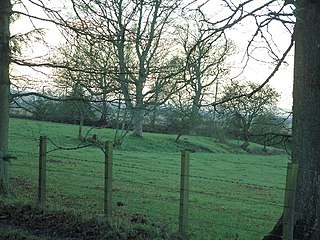
Carpow is a diffuse hamlet in Perth and Kinross, Scotland. It is situated immediately to the east of the confluence of the River Tay and River Earn, 2 km north east of Abernethy.

Prehistoric art in Scotland is visual art created or found within the modern borders of Scotland, before the departure of the Romans from southern and central Britain in the early fifth century CE, which is usually seen as the beginning of the early historic or Medieval era. There is no clear definition of prehistoric art among scholars and objects that may involve creativity often lack a context that would allow them to be understood.
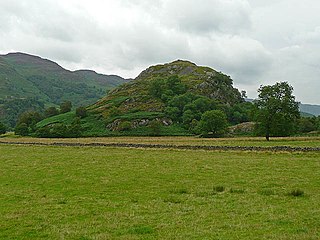
Dundurn is the site of a Pictish hillfort in what is now Strathearn in Perth and Kinross, Scotland.

The Govan Stones is an internationally-important museum collection of early-medieval carved stones displayed at Govan Old Parish Church in Glasgow, Scotland.
References
- ↑ Otto, Sasjkia (14 August 2009). "Bronze Age tomb found in Scotland". London: Telegraph.co.uk. Archived from the original on 17 August 2009. Retrieved 29 December 2009.
- 1 2 "The University of Glasgow::University news". The University of Glasgow website. University of Glasgow. 11 August 2009. Retrieved 30 December 2009.
- 1 2 Brophy, Kenneth; Noble, Gordon; Driscoll, Stephen (2010), "The Forteviot dagger burial", History Scotland, 10 (1): 12–13, ISSN 1475-5270
- ↑ Strathearn Environs & Royal Forteviot. Perth and Kinross Heritage Trust, project report 2006-2009. p.20.
- 1 2 "Unique Bronze Age burial uncovered". The Big Issue. 11 August 2009. Archived from the original on 7 May 2010. Retrieved 30 August 2010.
- 1 2 "Scottish Archaeologists Invite Public to Visit "Textbook" Bronze Age Burial Site". Heritage Key. 8 December 2009. Retrieved 10 March 2010.
- ↑ "4,000 year old flowers found at Bronze Age dig". BBC News. 15 December 2009. Retrieved 29 December 2009.
- 1 2 Keys, David (11 August 2009). "Ancient royal tomb found in Scotland". London: The Independent. Retrieved 29 December 2009.
- ↑ "Tomb reveals secrets of a 4000-year-old power lord". Herald. 12 August 2009. Retrieved 29 July 2010.
- ↑ "Scotlands History". BBC. Retrieved 28 July 2010.
- ↑ "Second season of the SERF project". University of Glasgow, Department of Archaeology. Archived from the original on 25 September 2010. Retrieved 1 August 2010.
- "Forteviot Bronze Age tomb". Megalithic Portal.